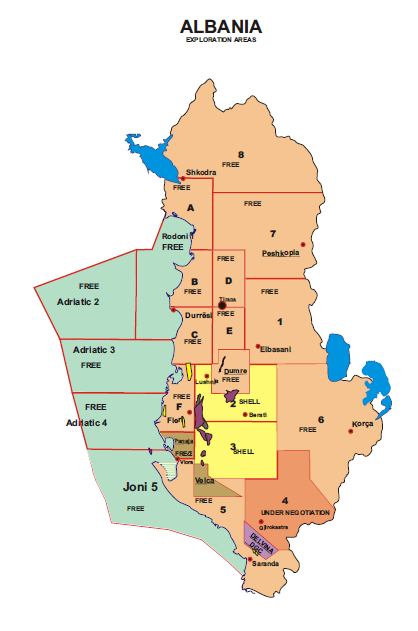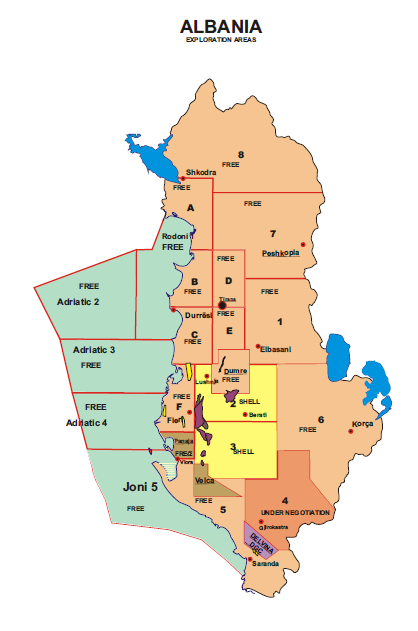Overview
State-run oil firm AlbPetrol estimates that Albania has recoverable oil reserves of around 120 million barrels, and natural gas reserves of 5.7 billion m3 gas. Patos-Marinza is one of continental Europe’s largest oilfields, and onshore and offshore oil and gas opportunities have attracted dozens of international companies to Albania over the years. Since 1992, dozens of new onshore wells have been drilled and thousands of new 2D, and some 3D, seismic profiles have been completed, onshore and offshore.
Companies that currently hold production-sharing agreements with AlbPetrol include:
Oil
- Patos Marinza – Bankers Petroleum (2004);
- Kucova – Sherwood International Petroleum/ Bankers Petroleum (2007)
- Visoka – Transoil Group (2009);
- Ballsh Hekal – Anio Oil and Gas (2007);
- Finiq-Krane and Pekisht-Murriz – Fin-Pek Petroleum (2013);
- Cakran-Mollaj, Gorisht –Kocul, and Amonica - Transoil Group (2018)
Gas
Divjake, Ballaj-Kryevidh, Povelce, Panaja, Finiq-Karne, and Frakull – AlbPetrol
Delvina – Delvina Gas Company Ltd (2016)
|
Company |
Oil and Gas Field |
2015 (ton) |
2016 (ton) |
2017 (ton) |
2018 (ton) |
2019 (ton) |
2020 (ton) |
|
Bankers Petroleum |
Patos-Marinza |
1,131,625 |
922,443 |
836,500 |
793.600 |
885,692 |
674,256 |
|
Anio Oil |
Ballsh-Hekal |
5,793 |
No data |
No data |
6,794 |
24,439 |
26.191 |
|
Sherwood International |
Kucova |
2,688 |
2,731 |
1,066 |
1,634 |
1,172 |
1,092 |
|
Transoil Group/ Terra Oil Swiss |
Visoka |
27,190 |
23,515 |
20,643 |
18,908 |
17,778 |
14,732 |
|
Fin-Pek Petroleum |
Amonicë–Pekisht-Finiq |
5,996 |
3,921 |
458 |
352 |
502 |
204 |
|
AlbPetrol |
Other |
47,574 |
46,959 |
92,800 |
89,458 |
75,415 |
40,918 |
|
TOTAL |
1,279,253 |
1,046,401 |
956,001 |
910,760 |
1,004, 998 |
757,362 |
Albania’s territory is divided into the following onshore and offshore blocks, some of which may offer opportunities for exploration and development of oil and gas fields.
The licensing of all vacant blocks is administered by the National Agency of Natural Resources (AKBN.)
Shell Upstream Albania, a wholly-owned subsidiary of Royal Dutch Shell, operates in blocks 2 and 3, where the company is currently assessing the commercial viability of its discovery of oil and gas. In 2018, Shell also signed an agreement for block 4. In Spring 2019, Shell annonunced that initial tests on the Shpirag-4 appraisal well near Berat confirmed the flow potential of a significant light oil discovery. Shell has drilled four different oil wells to date and plans to continue for at least two more years in the appreasal stage.
In December 2019, Italian Company ENI signed an exploration agreement for the onshore Dumrea block.
Onshore blocks 1, 6, 7, 8, A, B, C, D, E, and Panaja are vacant, and all offshore blocks are vacant.
In March 2021, Albania signed an agreement with ExxonMobil and Excelerate Energy to turn the Vlora thermal power plant (TPP) into a terminal for liquified natural gas (LNG). The construction of a new LNG terminal together with the expansion of the Vlore TPP can transform the coastal city into a regional hub for U.S. liquefied gas.
In March 2021, the Albanian gas operator Albgaz signed an MOU with the Italian SNAM for the development of the underground natural gas storage project in the Dumre area. This project aims to store up to 800 million cubic meter of natural gas based on an expected investment of $ 170 million.
Refining and oil imports & exports:
Albania has two aging refineries at Ballsh and Fier with refining capacity of 1 million tons and 0.5 million tons, respectively. In 2017, a third refinery began operations near Elbasan with an annual refining capacity of 250,000 tons. Albania exports much of its crude oil and imports most of its refined fuel. In 2020, imports under chapter 27 suffered significantly from the COVID related economic disruption and dropped to just $500 million a 28% reduction compared to the previous year.
Albania has two coastal oil and gas terminals: Porto Romano in Durres, and Petrolifera in Vlora. Each has capacity to store liquid petroleum gas, crude oil, diesel, gas, and additional liquids and dry products.
Gas market: Albania has very limited natural gas production. The completion of the Trans-Adriatic Pipeline (TAP) in January 2021 will deliver 10 bcm of Azeri gas to Southern Italy.
Leading Sub-Sectors
- Gas pipeline equipment
- Midstream oil equipment, including oil and gas pipelines and storage
- Equipment and services for offshore and onshore oil and gas exploration and production
- Oil and gas terminal products
- Gas station equipment, including for transportation
- Oil and oil by-products.
Opportunities
Existing oil production operations, and current and new oil and gas exploration licenses, both onshore and offshore, may represent opportunities to U.S. oil and gas companies and affiliated oil and gas service providers. The Trans-Adriatic Pipeline may offer opportunities for salt-dome gas storage, thermal energy generation, and the construction of downstream gas infrastructure and interconnectors. Plans are in place to expand the Southern Gas Corridor to include additional connectors, including the planned-Ionian Adriatic pipeline (IAP). The IAP, which would connect to TAP near the Albanian city of Fier, would carry up to 5 bcm of gas to Montenegro, Croatia, and Bosnia and Herzegovina. Opportunities also exist for exports of U.S. oil products, since Albania must import almost all of its refined fuel.
The following resources might be helpful when exploring for opportunities in the energy sector.
- Trans Adriatic Pipeline
- National Agency of Natural Resource (http://www.akbn.gov.al/)
- Ministry of Infrastructure and Energy (http://www.infrastruktura.gov.al/)
- AlbPetrol
- Shell
- Bankers Petroleum LTD
- Transoil Group
- Romanoport
- La Petrolifera Italo Albanese

